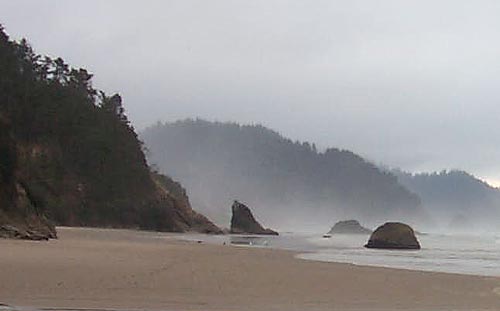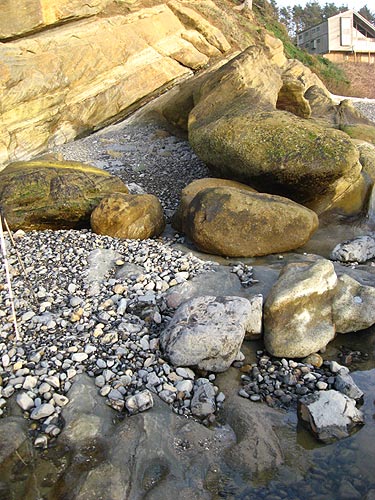A Look at the Crazy Things Oregon Coast Sand Levels Can Do
Published 11/09/2011

Includes exclusive listings; some specials in winter
In Cannon Beach:
Includes rentals not listed anywhere else
In Manzanita, Wheeler, Rockaway Beach:
Some specials for winter
In Pacific City, Oceanside:
Some specials for winter
In Lincoln City:
Some specials for winter
In Depoe Bay, Gleneden Beach:
Some specials for winter
In Newport:
Look for some specials
In Waldport
Some specials for winter
In Yachats, Florence
Some specials for winter
(Cannon Beach, Oregon) – It happens every year, without fail, but with varying intensity. Each winter storm season, Oregon coast beaches get scoured of sand by all that wave action, and sand levels drop. Then, as storm season passes and the waves and weather mellow out, this dynamic brings in more sand to the beaches, replenishing them.
Over the course of the year, sand levels rise and fall. When they drop, extraordinary things happen. Agates become abundant. Odd structures hidden beneath the sand can become evident. Sometimes even dramatic, historical finds are made, such as back in 2008 when sand levels dropped so low that a pair of historic cannon were found, shipwrecks appeared that no one knew about, and an old mail truck from the '30s was uncovered.

Hug Point – near Cannon Beach – is a prime example of the wild things that can happen with sand levels. At the top, you see this mushroom-shaped rock at the tide line, during what is a fairly normal sand level. But just above, this is what the area looked like in 2008, during sand levels that dropped ten feet or more in some spots.
Hug Point was one of them, where some wild things appeared all over this beach, and just to the south, at Arch Cape. You're practically seeing bedrock in some spots, certainly a huge bed of large cobblestones that didn't wash up here – they were under the sand.

Note this southern point at Hug Point, where you start to enter the beaches of Arch Cape. Here is what this area looks like normally.

Now, notice the same foot of this cliff at a low sand level event, where all of a sudden it's not easily traversible sand anymore, but large rock formations that make the place look more like Yachats on the central coast.

This shot above shows the size of the basalt formations you had to amble over – all of which lurk beneath these sands all the time.

Again, look at the southern tip of Hug Point, which is frequently covered by tide and often not traversible. Note the pointy rock and the smooth sands all around it.

Then see the area during another winter, with sand levels not as dramatically low as in 2008. This shot is actually more typical of the area during winters: the slope towards the ocean is greater, and a huge gravel bed appears that you don't see as much during the rest of the year.
 You'll see this kind of action everywhere on the coast: along the sandy beaches around Seaside, Depoe Bay, Lincoln City, Waldport, Oceanside, Pacific City, Manzanita and more. In Rockaway Beach, sand levels actually revealed a shipwreck for the first time in 50 years in late 2010. Around Lincoln City, Newport, Seal Rock and Oceanside, gravel beds appear that make for excellent agate hunting. Around Newport and Arch Cape, ancient structures called “ghost forests” appear – tree stumps that are 2,000 to 4,000 years old.
You'll see this kind of action everywhere on the coast: along the sandy beaches around Seaside, Depoe Bay, Lincoln City, Waldport, Oceanside, Pacific City, Manzanita and more. In Rockaway Beach, sand levels actually revealed a shipwreck for the first time in 50 years in late 2010. Around Lincoln City, Newport, Seal Rock and Oceanside, gravel beds appear that make for excellent agate hunting. Around Newport and Arch Cape, ancient structures called “ghost forests” appear – tree stumps that are 2,000 to 4,000 years old.
Sand levels drop differently each year; it's never the same. Some years it's not very much, some years it's quite dramatic.
Some areas appear to be replenishing less during the summers, according to Oregon geologists. This is an alarming trend as it could be a sign of climate change, and it would not bode well for the effects of climate change on the Oregon coast. This is not 100 percent certain as yet, but most geologists agree many beaches are not refilling with sand as much as they previously had, like Neskowin. Hotels in Cannon Beach - Where to eat - Cannon Beach Maps and Virtual Tours
Cannon Beach Lodging
Nehalem Bay Lodgings
Manzanita Hotels, Lodging
Three Capes Lodging
Pacific City Hotels, Lodging
Lincoln City Lodging
Depoe Bay Lodging
Newport Lodging
Waldport Lodging
Yachats Lodging
Oregon Coast Vacation Rentals
Oregon Coast Lodging Specials
More About Oregon Coast hotels, lodging.....
More About Oregon Coast Restaurants, Dining.....
LATEST Related Oregon Coast Articles
The wilds of the coast and hang gliding, boating, mussels, hiking, fishing, crabbing, sandboarding, more. Sciences
Cool to Kooky Things That Sand Levels Can Do to Oregon Coast in Summer
Sometimes hundreds of feet are added and you can access hidden things. Sciences. Cannon Beach, Arch Cape, Arcadia Beach, Hug Point, Lincoln City, Oceanside, Newport
When Sand Dollars Move on Oregon / Washington Coast the Unexpected Can Happen
They can inadvertently create art; how sand dollars move. Marine sciences
Oregon Coast's 'Master of the Dune' Shows Cutting-Edge Sandboard Art in Florence
Through Feb Lon Beale, founder of Sand Master Park shows wild art. Florence events
Cajoling Cracks 'n Crevices of One Out-of-the-Way Oregon Coast Beach Near New...
Holes slowly becoming caves and sandy intrigue. Travel tips, Waldport, Seal Rock
Future of N. Oregon Coast: Three Capes' Sandlake Road Bridge Will Get Replaced
Surveying begins with construction in 2026
Florence's Fall Fest Includes Kites, Circles in the Sand - and Oregon Coast's...
Nov 9 - 10 brings glowing kites to Driftwood Shores. Florence events
Netarts Sunset Bay Walk Shows Off Science and Photogenic Beauty of N. Oregon ...
October 15 you get to casually wander around the sands and learn. Oceanside events, Manzanita events
Back to Oregon Coast
Contact Advertise on BeachConnection.net
All Content, unless otherwise attributed, copyright BeachConnection.net Unauthorized use or publication is not permitted





















































